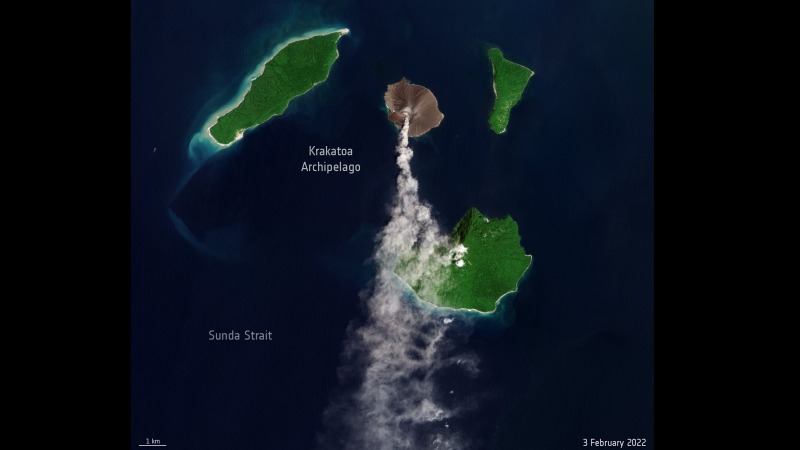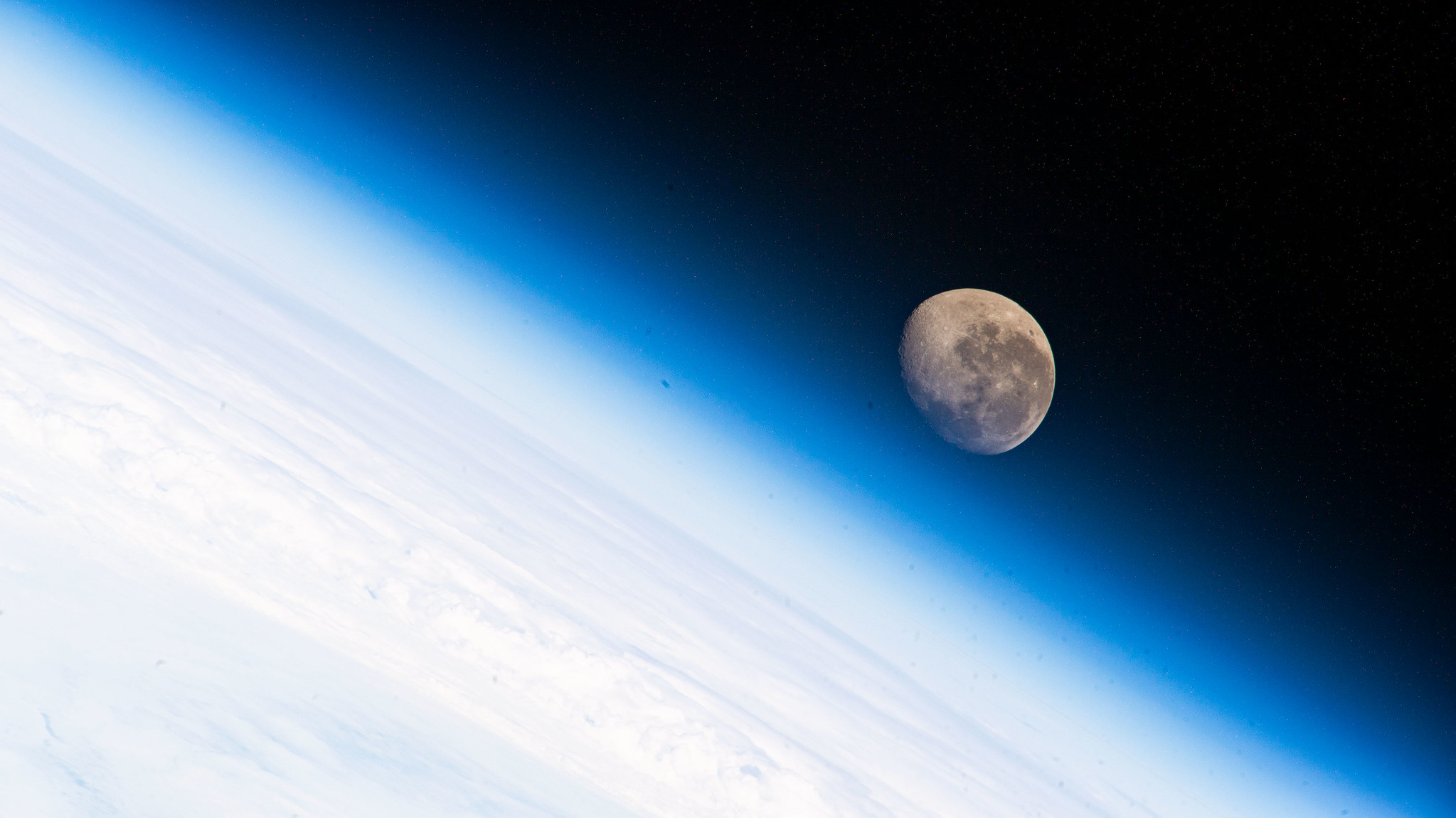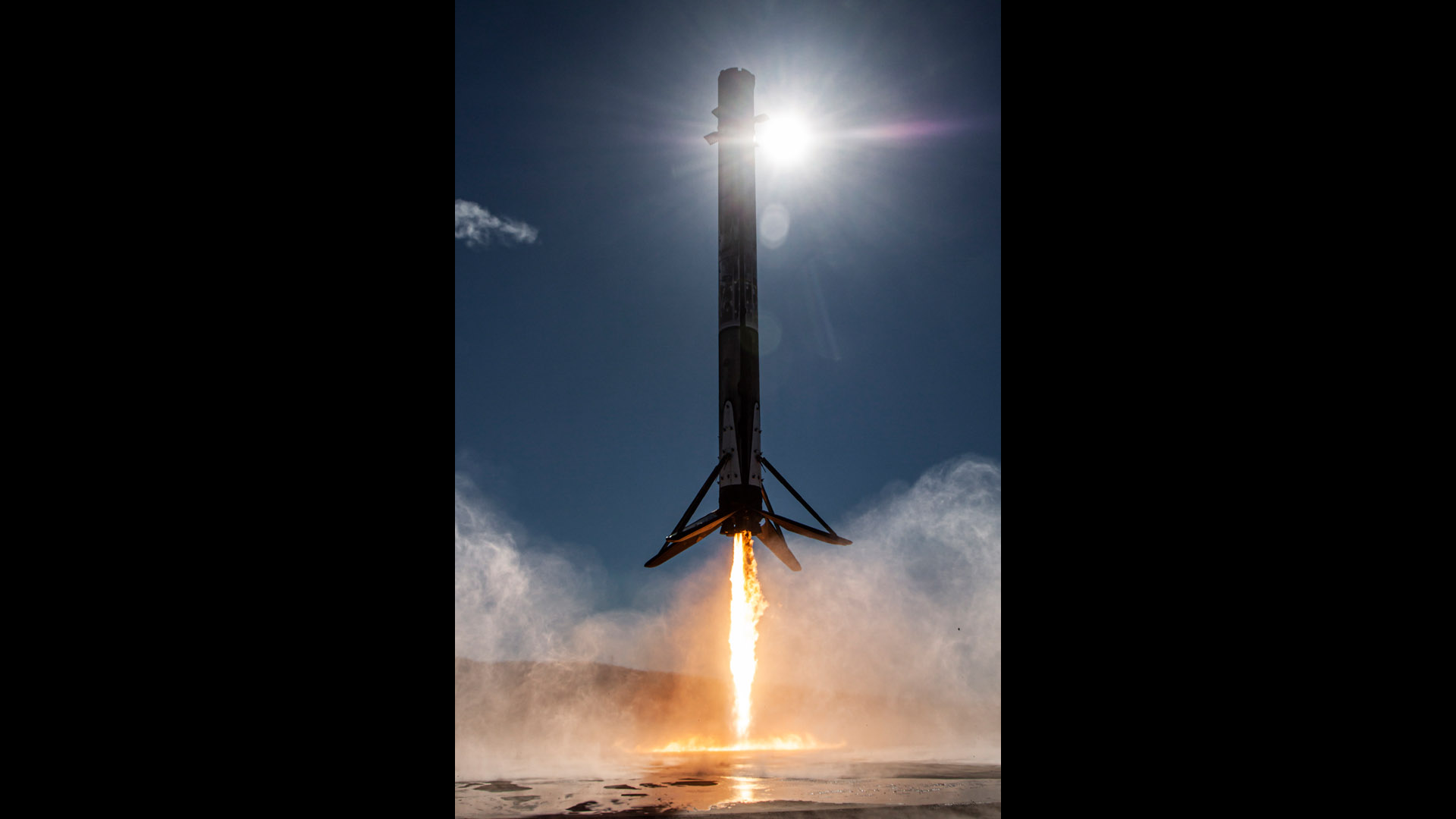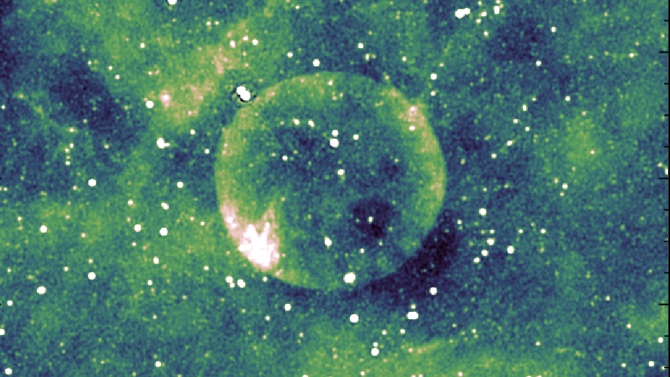February 2021
Southern aurora displays delight astronauts on space station

Monday, February 28, 2022: Southern polar lights, or aurora australis, lit up the sky above Antarctica, providing a mesmerizing spectacle to astronauts aboard the International Space Station.
The image was taken on Friday (Feb. 18), as the space station flew above the Indian Ocean at the altitude of 270 miles (435 kilometers) – Tereza Pultarova
Radar satellite reveals more Russian troops near Ukraine's borders

Friday, February 25, 2022: Radar satellites of U.S. Earth-observation company Capella Space captured this image of Russian troops assembling near the collapsed Chernobyl nuclear power plant close to the borders of Ukraine.
The image, acquired on Friday (Feb. 25), shows troops crossing a pontoon bridge on the Belarus side of the border near the abandoned city of Pripyat. The troops are entering the exclusion zone around the power plant that exploded in 1986. The area is still considered a disaster zone with dangerously high levels of radiation. – Tereza Pultarova
Astronaut's ISS flashbacks of war in Ukraine

Thursday, February 24, 2022: Retired NASA astronaut Terry Virts shared this image of bomb explosions in eastern Ukraine, taken from the International Space Station in 2015, on his Twitter account as Russia's dictator Vladimir Putin unleashed a full-scale invasion of its neighbor state.
Virts, who spent seven months on the orbital outpost, working closely with Russian colleagues during two missions in 2010 and 2014, condemned the actions of Russia and called into question the sustainability of the long-standing cooperation in space between the western countries and the Eastern European aggressor.
"I took this picture of Eastern Ukraine (Moscow in the distance) in the winter of 2015, when I sadly watched Russian bombs killing Ukrainians down on Earth," Virts said in the tweet. "Today Vladimir Putin has chosen an even worse course. Please share this if you stand with #Ukraine & against his violence."
Get the Space.com Newsletter
Breaking space news, the latest updates on rocket launches, skywatching events and more!
Virts, who retired from NASA in 2016, said in a separate post that he believed Putin's actions would bring the member states of the The North Atlantic Treaty Organization (NATO) closer together and called on "everyday Russians" whose sons will be dying fighting their "cousins" in Ukraine to stand against Putin. – Tereza Pultarova
Satellites see Russian troops assembling near Ukraine's border

Wednesday, February 23, 2022: Earth observation satellites of U.S. company Maxar Technologies captured images of Russian troops assembling near the borders with Ukraine.
In this image, taken on Tuesday (Feb. 22), over a hundred army vehicles can be seen at the Bolshoy Bokov airfield in southern Belarus, less than 25 miles (40 kilometers) from the border with Ukraine.
Other images show troops assembling in Western Russia, increasing concerns that Russia's leader Vladimir Putin may be planning a wide-ranging invasion of Ukraine. Russia annexed the formerly Ukrainian Crimea peninsula, an area with a high proportion of Russian population, already in 2014. Since then, a civil war has been raging in Eastern Ukraine between Russia-backed separatists and the Ukrainians, which has since claimed 14,000 lives.
Earlier this week, Russia moved its troops into two regions in Eastern Ukraine on the pretext of maintaining peace and protecting the Russian population. Western countries, however, worry that Russia's President Vladimir Putin may be planning a complete takeover of Ukraine. – Tereza Pultarova
Satellite capture's Peru's worst ever oil spill caused by Hunga Tonga tsunami

Tuesday, February 22, 2022: A massive oil spill off the coast of Peru can be seen in this image captured by the European Sentinel-2 satellite in the aftermath of the Hunga Tonga volcanic eruption.
The oil spill, the worst in the history of Peru, whose economy is reliant on fishing, was first reported on Jan. 15 after the massive volcanic eruption in Polynesia sent tsunamis across the Pacific Ocean.
This image reveals the situation on Feb. 2, over two weeks after the incident. According to Peru's Ministry of the Environment, some 11,900 barrels of oil leaked into the sea from a tanker operated by the Spanish-owned oil company Repsol. According to Repsol, the tanker was hit by the waves triggered by the eruption just as it was offloading crude oil into a refinery near Peru's capital Lima.
According to reports, the oil slick has spread to more than 20 beaches stretching over 25 miles (41 kilometres) of coastline. In this image, the oil spill can be seen licking the Ancón Reserved Zone, an area protected for its biodiversity and ecological value, and the similarly biologically valuable Pescadores Islets. – Tereza Pultarova
Cygnus cargo spacecraft approaches space station

Monday, February 21, 2022: The Cygnus NG-17 cargo spacecraft approaches the International Space Station on Monday (Feb. 21).
The spacecraft, launched on Saturday (Feb. 19) aboard an Antares rocket from NASA's Wallops Flight Facility in Virginia with 8,300 pounds (3,765 kilograms) of scientific experiments, food and other supplies aboard.
NASA astronaut Raja Chari captured the vehicle at 4:44 a.m. EST (0944 GMT) with the space station's robotic arm, while the two spacecraft flew over the Indian Ocean. A little over two hours later, at 7:02 a.m. EST (1202 GMT), the robotic arm attached Cygnus NG-17 to the space station's Unity module.
Named S.S. Piers Sellers after the late NASA astronaut and former director of the agency's Earth Science Division, the spacecraft will remain docked to the orbital outpost until about late May. During this time, the spacecraft will perform its first ever reboost maneuver to push the space station to a slightly higher altitude to counteract the drag of Earth’s residual atmosphere, which pulls the ISS down over time. – Tereza Pultarova
Volcanic power viewed in orbit

Friday, February 18, 2022 – Mighty Mount Etna is continuing to erupt and has been caught in several recent International Space Station pictures, including this one posted on Twitter from Matthias Maurer.
"@astro_luca's home volcano #Etna is clearly smoking (and spitting lava as I learnt from the news) 🌋," wrote European Space Agency astronaut Matthias Maurer on Saturday (Feb. 12), referring to fellow ESA spaceflyer Luca Parmitano, who is from Italy. (Etna is a Sicilian volcano.)
Mount Etna was quite active in 2021, allowing it to grow by 100 feet (30 meters) in a few months due to accumulated lava flows. It is being observed not only by astronauts, but also by numerous satellites that are trying to get a sense of how the volcano affects the local environment.
In general, volcanic plumes can lead to issues including air traffic risks and, closer to the ground, sulfur dioxide that interferes with human respiration. – Elizabeth Howell
Dusty Mars lander running low on solar power

Thursday, February 17, 2022 – While NASA's InSight Mars lander pulled through a local dust storm after temporarily going into safe mode, its days are likely numbered. A new NASA update says the lander, which has been operating on the surface since 2018, has just enough power to continue science work "into the summer."
"Several weeks after the end of a dust storm on Mars, the solar panels of NASA's InSight lander are producing almost as much power as they did before the storm," NASA officials wrote Tuesday (Feb. 15).
"Having completed all primary mission science objectives, the goal now is to enable the spacecraft to operate through the end of its extended mission in December," Tuesday's update adds. "A passing whirlwind that removes dust or a new dust storm that increases the dust accumulation could alter the timeline." -- Elizabeth Howell
Progress spacecraft flies to ISS amid program changes

Wednesday, February 16, 2022 – The Russian Progress 80 cargo spacecraft lifted off Tuesday (Feb. 15) from the Baikonur Cosmodrome en route to the International Space Station. The cargo launch is happening at a moment when Russia is looking to retool its orbital trajectories for such ships to make future ISS deliveries faster and more efficient.
Roscosmos announced recently that it plans to shorten Progress deliveries to a single-orbit, two-hour journey to the orbiting lab. Implement of that superfast route is expected in 2023 if planning and implementation go as the Russian space agency hopes.
While Roscosmos has been sending Progresses to the station in as little as two orbits (three hours) since 2018, Progress 80 will take a little longer. The spacecraft is scheduled for 30 orbits before arriving at the ISS early Thursday (Feb. 17). – Elizabeth Howell
Triple galaxy merger caught in deep space

Tuesday, February 15, 2022 – The Hubble Space Telescope caught an intriguing glimpse of a "weird and wonderful" trio of galaxies merging several hundred million light-years away, according to the European Space Agency. The merging galaxies, known as IC 2431, are producing a lot of environmental effects. This activity is generating star formation and distortions in the area due to all the gravitational interactions between the trio, ESA said.
At the center of the image is a cloud of dust obscuring the view, although you can see light from a background galaxy peeking around the edges. The merger was found as part of the Galaxy Zoo citizen science project, which is examining images from Hubble's Advanced Camera for Surveys. -- Elizabeth Howell
Webb glows in the dark

Monday, February 14, 2022 – This haunting picture shows the James Webb Space Telescope's hexagon mirrors working in deep space. NASA released the image on Friday (Feb. 11), which was taken in darkness using Webb's near-infrared camera (NIRCam) instrument.
Engineers were astonished that the camera was able to do this work so well, as part of the alignment procedures for Webb. "I think pretty much the reaction [to the selfie] was, 'Holy cow,' " Lee Feinberg, Webb optical telescope element manager at NASA Goddard Space Center, said of his team's reaction to the selfie. -- Elizabeth Howell
A Starship rises

Friday, February 11, 2022: SpaceX CEO Elon Musk shared a picture of the Starship spacecraft and launching system on Twitter ahead of a huge program update late Thursday (Feb. 10). After reiterating his hopes to reach orbit soon, Musk said he plans to lower launch costs through a substantially higher launch rate.
The hope is to launch a Starship vehicle every six to eight hours, and a Super Heavy roughly every hour. "It may be as little as a few million dollars per flight — maybe even as low as a million dollars per flight," Musk said.
These extremely low launch costs would make Mars colonization a possibility, although they have yet to be proven and SpaceX would need to pass strict environmental standards before being approved for the increased rate. A current Federal Aviation Administration environmental review has delayed company hopes from orbiting Starship for the first time in 2021. -- Elizabeth Howell
Krakatoa erupts anew

Thursday, February 10, 2022: Satellite images are helping to monitor activity at the Krakatau volcano in Indonesia, which re-erupted on Feb. 3. A new photo from the European Space Agency's (ESA's) Copernicus Sentinel-2 spacecraft shows the eruption billowing gas and possible ash as high as 656 feet (200 meters) above the crater. The activity was high enough to prompt the Anak Krakatau Volcano Observatory to raise the aviation color code to orange, ESA reported. A devastating 1883 eruption of Krakatau (also known as Krakatoa) killed 36,000 people and darkened skies worldwide for years. -- Elizabeth Howell
A moon with a view

Wednesday, February 9, 2022: The moon, NASA's target for its Artemis program, shines as a tantalizing destination in this photo taken by an astronaut on the International Space Station. This image was taken by a member of the station's current Expedition 66 crew on Jan. 21, and shows a waning gibbous moon phase as the the moon shines above a brilliant Earth. The station was flying about 272 miles above the Atlantic Ocean at off the coast of southern Argentina when this image was taken. -- Tariq Malik
Hubble spies a space 'chamaeleon'

Tuesday, February 8, 2022: NASA's Hubble Space Telescope has captured a stunning new view of a stellar nursery illuminated by the bright blue light of young stars. This view shows the Chamaeleon Cloud Complex, a structures that stretches 65 light-years wide and is located about 522 light-years from Earth. It took Hubble 23 different observations to collect the images used to make this mosaic, and it only shows one of three different segments of the huge structure! -- Tariq Malik
Space sunrise serenity

Monday, February 7, 2022: An astronaut on the International Space Station captured this stunning view of a sunrise from space in January 2022 as the orbiting lab soared high above Earth. This particular view shows a sunrise as seen from the station while flying about 257 miles above Venezuela.
While the image is stunning, it doesn't mean the astronaut who took it had to rise before dawn to capture it. "As the station orbits the Earth, completing one trip around the globe every 92 minutes, the astronauts experience 15 or 16 sunrises and sunsets every day," NASA officials wrote in an image description. -- Tariq Malik
Satellite observes as cyclone Batsirai batters Madagascar

Friday, February 4, 2022: The European Earth-observing satellite Sentinel 3 has taken this image of the cyclone Batsarai approaching the coast of Madagascar n Friday (Feb. 4).
The cyclone brought torrential rains and strong winds to the island off the coast of east Africa after battering the small French-governed island of Reunion. Wind gust speeds of 124 mph (200 km/h) were recorded on Reunion, where an oil tanker capsized in the rough sea.
Batsarai is already the second cyclone to hit the region in two weeks after storm Ana, which killed about 50 people on Madagascar and forced 130,000 to flee their homes. – Tereza Pultarova
Falcon 9 booster lands after spy satellite launch

Thursday, February 3, 2022: A Falcon 9 rocket booster lands on a pad at Vandenberg Space Force Base in California after lifting a secretive U.S. spy satellite to orbit.
The booster landed about 8 minutes after the rocket's lift-off on Wednesday (Feb. 2).
The satellite, NROL-87, part of the National Reconnaissance Office family of satellites, carries classified instruments and not much is known about its upcoming activities.
The launch was the second in a string of three SpaceX launches conducted in only four days. On Monday (Jan. 31), the company delivered to space the Italian CSG-2 Earth-observation satellite from the Cape Canaveral Space Force Station in Florida. On Thursday, it plans to launch a batch of 49 satellites of its Starlink internet beaming constellation from NASA's Kennedy Space Center, which is also on Florida's Space Coast. – Tereza Pultarova
Simulating moon underwater

Wednesday, February 2, 2022: Divers at NASA's Neutral Buoyancy Laboratory have turned off the lights to experience how astronauts would feel on the moon's south pole.
NASA's Artemis mission aims to land humans on the moon again by 2025 and this time they are targeting the lunar south pole. There are many advantages to landing on the moon's south pole. For example, there could be water in its permanently shaded craters. But the lack of light will also make it difficult for astronauts to navigate around.
NASA shared the image on Twitter on Wednesday (Feb. 2). – Tereza Pultarova
Perseverance takes new sample after choking incident

Tuesday, February 1, 2022: NASA's Perseverance Mars rover has taken a new sample from a rock called Issole after the first attempt led to a choking incident that halted the rover's operations for two weeks.
NASA shared the image of the rock with a brand new hole in it on its Twitter account on Monday (Jan. 31).
"This rock almost looked surprised that I was coming back!" the rover team tweeted. "Thankfully, I was able to collect another sample here to replace the one I discarded earlier."
The agency added that this particular sample might be one of the oldest collected by the rover so far, hence the interest to return to the rock.
"It could help us understand the history of this place," the team said.
Perseverance landed in the 28-mile-wide (45 kilometers) Jezero Crater on the Northern Hemisphere of Mars on 18 February 2021. About six months later, the rover commenced perhaps the most exciting part of its mission — collecting samples for a future delivery to Earth. The sample return mission is yet to be developed, a task already tackled in cooperation between NASA and the European Space Agency.
Perseverance's previous attempt to collect a rock sample ended in an emergency situation after the fragments of the rock got stuck in the sampling tube. The ground teams realized something was wrong in late December when the rover's robotic arm failed to seal the tube after it placed it into the bit carousel, a rotating wheel-like structure on the rover's chassis that stores the samples.
Last week, the rover team announced all of the stuck samples were successfully removed. – Tereza Pultarova
Can't find the date you're looking for? It may have been a weekend or holiday, when we don't normally update our Image of the Day.
Click 'NEXT PAGE' below for March >
Join our Space Forums to keep talking space on the latest missions, night sky and more! And if you have a news tip, correction or comment, let us know at: community@space.com.

Space.com is the premier source of space exploration, innovation and astronomy news, chronicling (and celebrating) humanity's ongoing expansion across the final frontier. Originally founded in 1999, Space.com is, and always has been, the passion of writers and editors who are space fans and also trained journalists. Our current news team consists of Editor-in-Chief Tariq Malik; Editor Hanneke Weitering, Senior Space Writer Mike Wall; Senior Writer Meghan Bartels; Senior Writer Chelsea Gohd, Senior Writer Tereza Pultarova and Staff Writer Alexander Cox, focusing on e-commerce. Senior Producer Steve Spaleta oversees our space videos, with Diana Whitcroft as our Social Media Editor.
